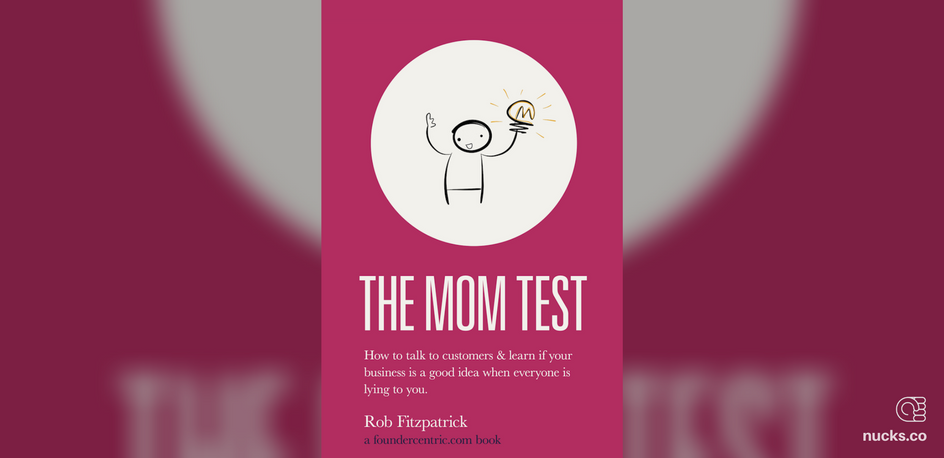Overview
Rating: 10/10
Read More on Amazon
High-Level Thoughts
One might argue that one of the most important activities in a business is customer development and research. Skipping that one step can cause years of misguided work. The Mom Test teaches not only how to ask questions, but it teaches how to build the correct questions. I would have saved countless years of wasted time if I had read this book years ago. I recommend it to anyone who wants to build what customers want.
Key Takeaways
- When doing research, ask about someone’s behavior, not hypotheticals.
- People will lie to you. It’s your job to make sure they don’t by asking correct questions.
- Questions you ask should terrify you. They could disprove what you’re researching.
Summary Notes
This methodology is not meant to replace the entire process of Customer Development. To read more about that, check out 4 Steps to the Epiphany and The Startup Owner’s Manual.
Why “The Mom Test” is Needed
Most startup founders know they have to get answers from customers. Yet, even with customer responses, they build the wrong things. This happens because founders don’t ask the right questions in the right way, which leads to customers that lie to them. Rob points out that doing customer development work incorrectly is worse than not doing it all. And sadly, most of us are not doing it correctly.
The truth is our goal and questions are our tools. But we must learn to wield them. It’s delicate work.
Never Ask If a Business Is a Good Idea
The way to discover if your business is a good idea is to never mention it at all. Instead, talk to people about their lives and their behavior. Ask about specifics from the past and forget about asking opinions about the future. It’s more important to listen than talk in these discussions.
If they haven’t looked for ways of solving it already, they’re not going to look for (or buy) yours.
Examples of Questions
| Bad | Good |
| Do you think it’s a good idea? | Why do you bother? |
| Would you buy a product which did X? | What are the implications of that? Talk me through the last time that happened. Talk me through your workflow. |
| How much would you pay for X? | What else have you tried? |
| What would your dream product do? | How are you dealing with it now? Where does the money come from? |
| Would you pay X for a product that did Y? | Who else should I talk to? |
| Do you think your husband would use this? | Is there anything else I should have asked? |
If the answers won’t affect what you’re doing, you’re asking the wrong questions. Your questions should be able to disprove your business. They should scare you.
How to Unearth Your 3 Big Questions
The way to find scary questions that will disprove your business can come from asking your team these questions:
- If this company fails, what is most likely to have killed it?
- If this company were to fail, why would it have happened?
- What would have to be true for this to be a huge success?
The answers should be simple and give you a good idea of what questions will be valuable in your interviews.
Generally, the people you talk with will know about their problems but will not know how to solve them.
They Own the Problem, You Own the Solution
You aren’t allowed to tell someone what their problems are, but they aren’t allowed to tell you what to build. Always listen carefully to what they say, but it’s your job to find a solution to their problem.
You can know you’re on the wrong path if you interpret incorrectly and listen to bad data.
Types of Bad Data
- Compliments
- Fluff (generics, hypotheticals, and the future)
- Ideas
| Type | Example |
| Compliments | “I love it!” |
| Fluff | “I usually”, “I always”, “I never”, “I would”, “I will”, “I might”, “I could”, “I would definitely buy that.” |
| Ideas | “I bet if you did it this way…” |
By ignoring bad data, you can steer the conversation down a path that will be useful for your company.
How to Approach Your Customer Conversations
Start broad and zoom in once you’ve found a strong signal. Every conversation should begin at a higher level. Discover if they care about the problem category and then zoom in little by little. The conversations should not feel formal. They should be quick and easy chats.
When you set up a meeting, you need to be in control. Set an agenda, keep it on topic, and propose the next steps.
Follow this mnemonic: Very Few Wizards Properly Ask [for help]
Vision - “Hey Pete, I’m trying to make desk & office rental less of a pain for new businesses.”
Framing - “We’re just starting out and don’t have anything to sell, but want to make sure we’re building something that actually helps.”
Weakness - “I’ve only ever come at it from the tenant’s side and I’m having a hard time understanding how it all works from the landlord’s perspective.”
Pedestal - “You’ve been renting out desks for a while and could really help me cut through the fog.”
Ask - “Do you have time in the next couple of weeks to meet up for a chat?”
You should keep these conversations going until you stop hearing new stuff.
Customer Slicing
If you find yourself talking to several different personas and are confused, you need to zoom in. The more narrow that you get, the more clear the solution and answers will become for your business. The drilling down is referred to as Customer Slicing.
Take a broad segment and ask: Which type of person would want this most? Would everyone buy it, or only some? Why do they want it? What motivations are there? What other types of people have these motivations? You can continue slicing your segments until you have a more precise group of customers.
Then you can decide which customer segment is most profitable, easy to reach, and rewarding to build a business around.
Product Meetings
Once you have a product, you can begin scheduling in 30-minute blocks.
Here’s what that call would look like (with 5 minutes for tardiness):
5 mins - Hello
5 mins - Ask questions to understand goals/problems/budget
10 mins - Show and describe the product
5 mins - Next steps and advancement
The worst thing you can do is end the call without a commitment of time, reputation, or money. The more your customer gives up, the more seriously you can take their kind words. They are not a real lead unless you’ve given them a chance to reject you.
If you don’t know what happens next after a product or sales meeting, the meeting was pointless.
The goal of these early conversations is learning. Revenue will be a side effect.
Note: There is no reason to spend 5 minutes explaining to them why you’re there or why you’re starting a business. Instead, have a regular conversation.
Examples of Responses
| Bad | Good |
| “That’s so cool. I love it!” | “There are a couple of people I can intro you to when you’re ready.” |
| “Looks great. Let me know when it launches.” | “What are the next steps?” |
| “I would definitely buy that.” | “Can we start the trial?” |
| “Congrats. You’ve done some awesome work.” | “Can I buy the prototype?” |
| “Sweet! I’m glad you showed me this.” | “When can you come back to talk to the rest of the team?” |
Keep Your Eye Out for Earlyvangelists
Earlyvangelists = People who have the problem, know they have the problem, have the budget to solve the problem, and have already cobbled their own makeshift solution to the problem
There is a clear line between people who are emotional about what you are doing and those you are not.
Example: “Yeah, that’s a problem.” vs “THAT IS THE WORST PART OF MY LIFE AND I WILL PAY YOU RIGHT NOW TO FIX IT.”
Be Creative to Find Your Customers
- Teach
- Landing page test (talk to every person who signs up)
- Organize an event for professionals (knowledge exchange phone calls, a meetup)
- Always ask for intros. These are the best people to get warm intros from:
- Professors
- Top-tier investors
- People who promised favors
Willpower is a finite resource. The way to overcome difficult situations isn’t to power through, but rather to change your circumstances to require less willpower.
Other Tips for Customer Conversations
- Write down the exact quotes. You want them to be verbatim.
- The founders need to be in the meetings until you have a working business model and repeatable sales or marketing process.
- The meetings will go best with two people. One person to talk while the other person takes notes.
- Make note of any strong emotions during the conversation.
- Keep notes in a place that is: permanent and retrievable by everyone on the team, able to be sorted, able to be mixed, and able to be rearranged.
Don’t Spend Too Much Time in Customer Research
One to two weeks is the most time you should spend. Much more time than that will be wasteful. Once you have your bearings, you need to commit your potential customers to something.
How to Handle Feature Requests
Feature requests should be understood, but not obeyed. Dig into why the customer wants the feature. Why do they bother to do something a certain way? How are they coping without the feature?
The Entire Mom Test Process
- Choose a focused, findable segment
- With your team, decide big 3 learning goals
- Choose ideal next steps and commitments
- Create a series of best guesses about what the person cares about
- If the question can be answered via desk research, do that first
- Have conversations
- Frame the conversation
- Keep it casual
- Ask good questions
- Take good notes
- Press for commitment and next steps
- Review notes with team
- If relevant, transfer notes and update storage
- Update your beliefs and plans
- Decide on next 3 big questions
- Repeat
What Would I Change About the Book?
The beginning felt much more interesting than the end. I would have liked to gain the same amount of value throughout the entire book.
Want to Read More?
Other Reviews
#TheMomTest: clear, concise, practical guide to startup customer interviewing w/ great examples by @robfitz http://t.co/8amwoxfZWj
— Tom Eisenmann (@teisenmann) September 15, 2014
The terribly named book "The Mom Test" is the best resource I've seen on how to build products that people will actually use: https://t.co/ntYYv0SNGA
— Tim Trefren (@ttrefren) August 13, 2020



